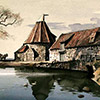The Pastel is a dry painting technique with excellent quality. The sticks are composed of pigment and tragacanth gum as a binder. The pastel has a velvety appearance on the paper, bright, attractive, and also, it´s a very grateful technique ideal for practicing with color, as being a dry technique it doesn´t need solvents or brushes.
Advantage
- It is a fast technique, closely related to the drawing, so this allows you to paint with speed and spontaneity.
- Pastel allows representation of reality. We can create very realistic works.
- The pastel brings vibrant and alive color. The last layer, not fixed with fixative, is a detached powder over the paper, and this way the color pigment has not been turned off with the binders.
- We can be combined ot with watercolor, acrylic, oil, collage, and other dry and wet techniques.
- The technique allows the additive method: gradually add layers of color over the painting.


Disadvantages
- Usually the pastel is over a paper and this makes the work more fragile, so it needs to be protected with glass.
- Color can get dirty by being free powder, so you need to know how to fix it with fixative or be very careful not to alter it and not beat him, nor winds, and nor have moisture while working. When finished, you should always protect the work.
- If you add too much paint, that is, too many layers, the work can be ruined, being too heavy and opaque.
- We can not completely clear as we do with other techniques, so that, errors are difficult to fix.
Easy step by step technique for painting with pastels.
This is a quick guide to start painting immediately.
- Decide the artistic theme and his format, support and expressiveness.
- Acquire a cardstock o Canson, cardboard or similar.(Paper with some texture, never thin sheets).
- You need a set of pastels sticks. The more colors the easier job. Color mixtures can be made in three ways:
1) Blurring different colors on the paper itself. Mixtures are there directly.
2) Generating optical mixtures by putting together the color strokes.
3) Putting on paper directly the exact color tone you want (the color stick has the exact color that you want). - To have a blending stump o hygienic paper to smudge and make the color layers that are below (which should be seen underneath in the image).
- Set the background color layers with Lacquer or spray fixative..
- Gradually add more layers of color as the image requires, fixing the painting if that layer will have more paint on. If we don´t fix the layer, the colors will join and we can lose color and tone performed.
- The last is to add some color touches that should be alive and vibrant. This should not be fix, or very little, so that the pastel retains his freshness and beauty.
- Framing glass.
Tricks for pastel technique
Pastel sticks should be stored in a box designed for them or in a box with rice, this way they don´t touche the others and are not dirty.
If you need darker colors and do not have, you can paint a black color and then apply above a layer with green, blue or another tone that will give color.
The sandpaper and brackets (cardboard or wood) primed with powdered pumice, are an excellent material for painting with pastels as they firmly adhere by high porosity.

Cristina Alejos paintings.

